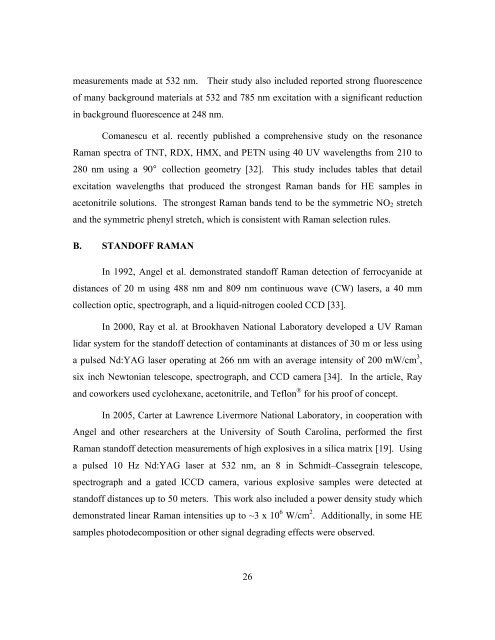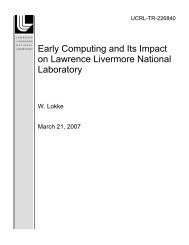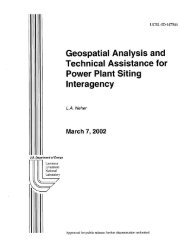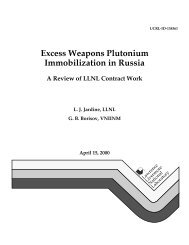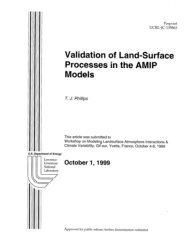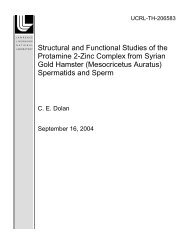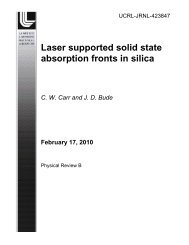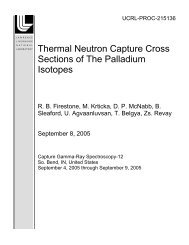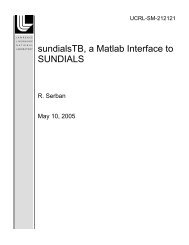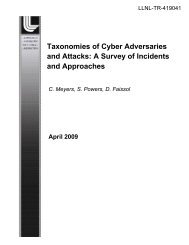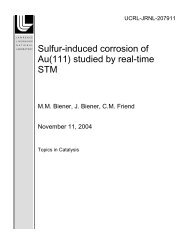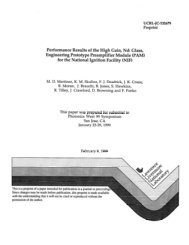Ultraviolet Resonant Raman Enhancements in the Detection of ...
Ultraviolet Resonant Raman Enhancements in the Detection of ...
Ultraviolet Resonant Raman Enhancements in the Detection of ...
You also want an ePaper? Increase the reach of your titles
YUMPU automatically turns print PDFs into web optimized ePapers that Google loves.
measurements made at 532 nm. Their study also <strong>in</strong>cluded reported strong fluorescence<br />
<strong>of</strong> many background materials at 532 and 785 nm excitation with a significant reduction<br />
<strong>in</strong> background fluorescence at 248 nm.<br />
Comanescu et al. recently published a comprehensive study on <strong>the</strong> resonance<br />
<strong>Raman</strong> spectra <strong>of</strong> TNT, RDX, HMX, and PETN us<strong>in</strong>g 40 UV wavelengths from 210 to<br />
280 nm us<strong>in</strong>g a collection geometry [32]. This study <strong>in</strong>cludes tables that detail<br />
excitation wavelengths that produced <strong>the</strong> strongest <strong>Raman</strong> bands for HE samples <strong>in</strong><br />
acetonitrile solutions. The strongest <strong>Raman</strong> bands tend to be <strong>the</strong> symmetric NO2 stretch<br />
and <strong>the</strong> symmetric phenyl stretch, which is consistent with <strong>Raman</strong> selection rules.<br />
B. STANDOFF RAMAN<br />
In 1992, Angel et al. demonstrated stand<strong>of</strong>f <strong>Raman</strong> detection <strong>of</strong> ferrocyanide at<br />
distances <strong>of</strong> 20 m us<strong>in</strong>g 488 nm and 809 nm cont<strong>in</strong>uous wave (CW) lasers, a 40 mm<br />
collection optic, spectrograph, and a liquid-nitrogen cooled CCD [33].<br />
In 2000, Ray et al. at Brookhaven National Laboratory developed a UV <strong>Raman</strong><br />
lidar system for <strong>the</strong> stand<strong>of</strong>f detection <strong>of</strong> contam<strong>in</strong>ants at distances <strong>of</strong> 30 m or less us<strong>in</strong>g<br />
a pulsed Nd:YAG laser operat<strong>in</strong>g at 266 nm with an average <strong>in</strong>tensity <strong>of</strong> 200 mW/cm 3 ,<br />
six <strong>in</strong>ch Newtonian telescope, spectrograph, and CCD camera [34]. In <strong>the</strong> article, Ray<br />
and coworkers used cyclohexane, acetonitrile, and Teflon ® for his pro<strong>of</strong> <strong>of</strong> concept.<br />
In 2005, Carter at Lawrence Livermore National Laboratory, <strong>in</strong> cooperation with<br />
Angel and o<strong>the</strong>r researchers at <strong>the</strong> University <strong>of</strong> South Carol<strong>in</strong>a, performed <strong>the</strong> first<br />
<strong>Raman</strong> stand<strong>of</strong>f detection measurements <strong>of</strong> high explosives <strong>in</strong> a silica matrix [19]. Us<strong>in</strong>g<br />
a pulsed 10 Hz Nd:YAG laser at 532 nm, an 8 <strong>in</strong> Schmidt–Cassegra<strong>in</strong> telescope,<br />
spectrograph and a gated ICCD camera, various explosive samples were detected at<br />
stand<strong>of</strong>f distances up to 50 meters. This work also <strong>in</strong>cluded a power density study which<br />
demonstrated l<strong>in</strong>ear <strong>Raman</strong> <strong>in</strong>tensities up to ~3 x 10 6 W/cm 2 . Additionally, <strong>in</strong> some HE<br />
samples photodecomposition or o<strong>the</strong>r signal degrad<strong>in</strong>g effects were observed.<br />
26


